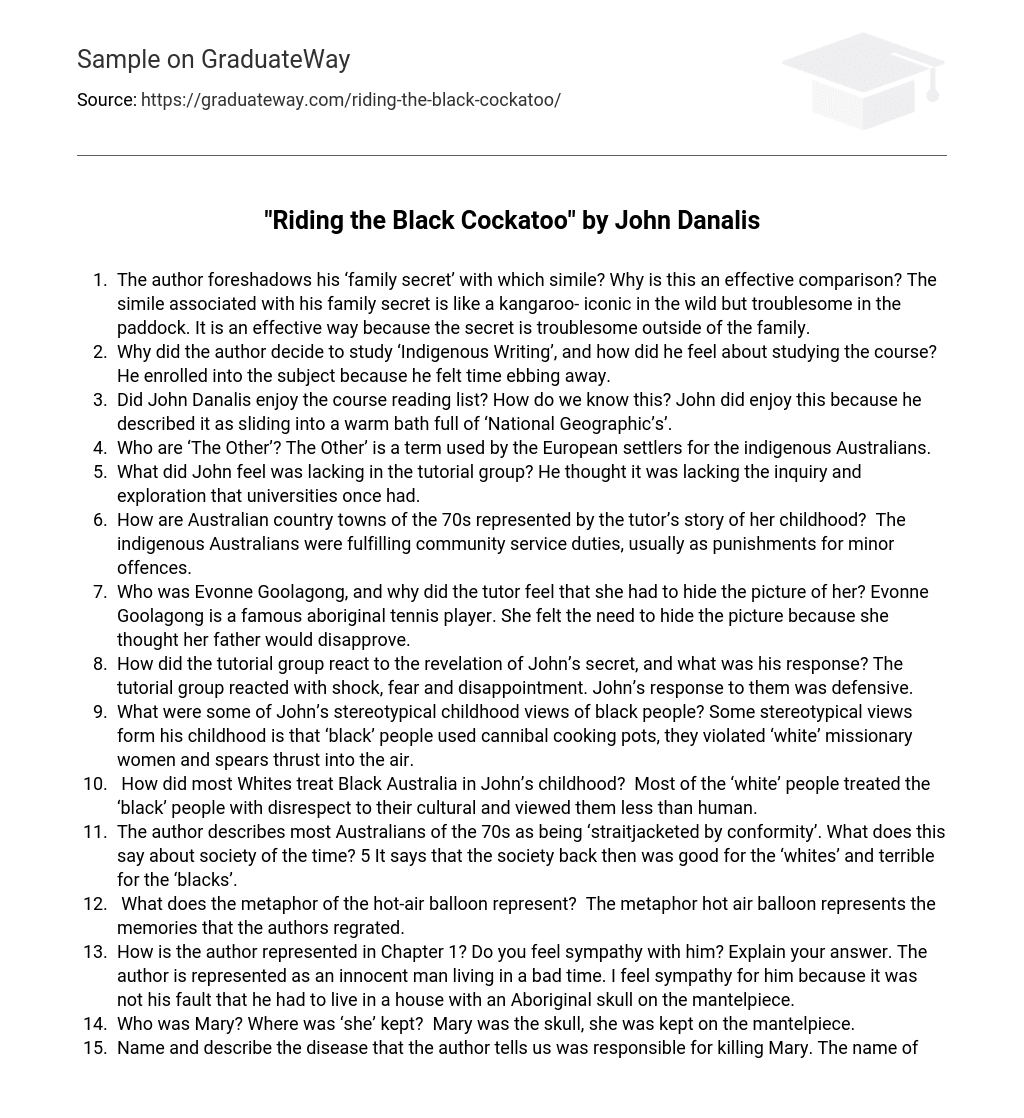- The author foreshadows his ‘family secret’ with which simile? Why is this an effective comparison? The simile associated with his family secret is like a kangaroo- iconic in the wild but troublesome in the paddock. It is an effective way because the secret is troublesome outside of the family.
- Why did the author decide to study ‘Indigenous Writing’, and how did he feel about studying the course? He enrolled into the subject because he felt time ebbing away.
- Did John Danalis enjoy the course reading list? How do we know this? John did enjoy this because he described it as sliding into a warm bath full of ‘National Geographic’s’.
- Who are ‘The Other’? The Other’ is a term used by the European settlers for the indigenous Australians.
- What did John feel was lacking in the tutorial group? He thought it was lacking the inquiry and exploration that universities once had.
- How are Australian country towns of the 70s represented by the tutor’s story of her childhood? The indigenous Australians were fulfilling community service duties, usually as punishments for minor offences.
- Who was Evonne Goolagong, and why did the tutor feel that she had to hide the picture of her? Evonne Goolagong is a famous aboriginal tennis player. She felt the need to hide the picture because she thought her father would disapprove.
- How did the tutorial group react to the revelation of John’s secret, and what was his response? The tutorial group reacted with shock, fear and disappointment. John’s response to them was defensive.
- What were some of John’s stereotypical childhood views of black people? Some stereotypical views form his childhood is that ‘black’ people used cannibal cooking pots, they violated ‘white’ missionary women and spears thrust into the air.
- How did most Whites treat Black Australia in John’s childhood? Most of the ‘white’ people treated the ‘black’ people with disrespect to their cultural and viewed them less than human.
- The author describes most Australians of the 70s as being ‘straitjacketed by conformity’. What does this say about society of the time? 5 It says that the society back then was good for the ‘whites’ and terrible for the ‘blacks’.
- What does the metaphor of the hot-air balloon represent? The metaphor hot air balloon represents the memories that the authors regrated.
- How is the author represented in Chapter 1? Do you feel sympathy with him? Explain your answer. The author is represented as an innocent man living in a bad time. I feel sympathy for him because it was not his fault that he had to live in a house with an Aboriginal skull on the mantelpiece.
- Who was Mary? Where was ‘she’ kept? Mary was the skull, she was kept on the mantelpiece.
- Name and describe the disease that the author tells us was responsible for killing Mary. The name of the dieses was syphilis or the pox; it is sexually transmitted dieses that if left untreated it would eat away the organs.
- John Danalis describes his parents’ home in this chapter, and how Mary once sat proudly on their mantelpiece. Explain why Mary was moved from that spot and stored out of sight. It was moved out of sight because they wanted it to be kept a secret.
- John referred to his father as “a collector”. List four things he had collected. He collected curios, Mary, old AFL tapes and antique bottles.
- What was John’s father’s “other passion”? His other passion was sports.
“Riding the Black Cockatoo” by John Danalis
In this chapter, the author uses a simile to foreshadow his family’s secret, comparing it to a kangaroo that is iconic in the wild but troublesome in the paddock. He enrolled in the ‘Indigenous Writing’ course because he felt time ebbing away and enjoyed the reading list. ‘The Other’ refers to the indigenous Australians, who were treated with disrespect by most ‘white’ people in John’s childhood. The tutorial group reacted with shock, fear, and disappointment when John revealed his family secret, and he had stereotypical views of black people from his childhood. Society of the time was straitjacketed by conformity, and the metaphor of the hot-air balloon represents the memories that the author regrets. The author is represented as an innocent man living in a bad time, and Mary was the skull kept on the mantelpiece. Syphilis or the pox was responsible for killing Mary, and it was moved out of sight to keep it a secret. John’s father was a collector of curios, old AFL tapes, antique bottles, and had a passion for sports.
Cite this page
“Riding the Black Cockatoo” by John Danalis. (2016, Nov 23). Retrieved from
https://graduateway.com/riding-the-black-cockatoo/





